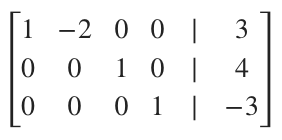Pivot entries and row-echelon forms
Pivot entries are the starting point for putting matrices into reduced row-echelon form
Now that we know how to use row operations to manipulate matrices, we can use them to simplify a matrix in order to solve the system of linear equations the matrix represents.
Our goal will be to use these row operations to change the matrix into either row-echelon form, or reduced row-echelon form.
Hi! I'm krista.
I create online courses to help you rock your math class. Read more.
Let’s start by defining pivot entries, since they’re part of the definitions of row-echelon and reduced row echelon forms.
Pivot entries
Before we can understand row-echelon and reduced row-echelon forms, we need to be able to identify pivot entries in a matrix.
A pivot entry, (or leading entry, or pivot), is the first non-zero entry in each row. Any column that houses a pivot is called a pivot column. So in the matrix
the pivots are ???4???, ???2???, and ???-3???. And all three of the columns on the left side are pivot columns, since they each house a pivot entry.
Row-echelon forms
A matrix is in row-echelon form (ref) if
All the pivot entries are equal to ???1???.
Any row(s) that consist of only ???0???s are at the bottom of the matrix.
The pivot in each row sits in a column to the right of the column that houses the pivot in the row above it. In other words, the pivot entries sit in a staircase pattern, where they stair-step down from the upper left corner to the lower right corner of the matrix.
Row-echelon form might look like this:
In this matrix, the first non-zero entry in each row is a ???1???, the row consisting of only ???0???s is at the bottom, and the pivots follow a staircase pattern that moves down and to the right, so it’s in row-echelon form.
If a matrix is in row-echelon form (the matrix meets the three requirements above for row-echelon form), and if, in each pivot column, the pivot entry is the only non-zero entry, then the matrix is in reduced row-echelon form (rref). Reduced row-echelon form could look like this:
In this matrix, the first non-zero entry in each row is a ???1???, there are no rows consisting of only ???0???s, so we don’t need to worry about that requirement, the pivots follows a staircase pattern that moves down and to the right, and all three pivot columns include only the pivot entry, and otherwise only ???0??? entries. The second column includes a non-zero entry, but it’s not a pivot column, so that’s okay, and this matrix is in reduced row-echelon form.
This is what reduced row-echelon form often looks like for ???2\times2???, ???3\times3???, and ???4\times4??? augmented matrices:
If you do find a row of zeros in a matrix, either in row-echelon form or reduced row-echelon form, it tells you that the zero row was a combination of some of the other rows. It could be a multiple of another row, the sum or difference of other rows, or some other similar kind of combination.
How to rewrite matrices in both row-echelon (ref) and reduced row-echelon (rref) form
Take the course
Want to learn more about Linear Algebra? I have a step-by-step course for that. :)
Using row operations to put a matrix into reduced row-echelon form
Sometimes it’s fairly simple to put a matrix into row-echelon or reduced row-echelon form.
Example
Use row operations to put the matrix into reduced row-echelon form.
Notice that we can multiply ???R_2??? by ???1/5??? (or equivalently, divide ???R_2??? by ???5???).
Now we need to put the pivot entries into a staircase pattern. Switch the first and second rows, ???R_1\leftrightarrow R_2???.
Switch the third and fourth rows, ???R_3\leftrightarrow R_4???.
Now all the pivot entries are ???1???, the zeroed-out row is at the bottom, the pivot entries follow a staircase pattern, and all the pivot columns include only the pivot entry, and otherwise all ???0??? entries. So the matrix is in reduced row-echelon form.
Now all the pivot entries are 1, the zeroed-out row is at the bottom, the pivot entries follow a staircase pattern, and all the pivot columns include only the pivot entry, and otherwise all 0 entries. So the matrix is in reduced row-echelon form.
Let’s talk for a second about why we would want to put a matrix into rref. Remember that a rref matrix
is still representing a system of linear equations. So if we’ve put the matrix into reduced row-echelon form and then we pull back out the linear equations represented by the matrix, we get
???1x+0y+0z=a???
???0x+1y+0z=b???
???0x+0y+1z=c???
or just
???x=a???
???y=b???
???z=c???
In other words, from reduced row-echelon form, we automatically have the solution to the system! So what we’re saying is that, if we put the matrix into its reduced row-echelon form, then we can pull out the value of each variable directly from the matrix. You can almost think about reduced row-echelon form as the simplest, most “cleaned up” version of a matrix.















